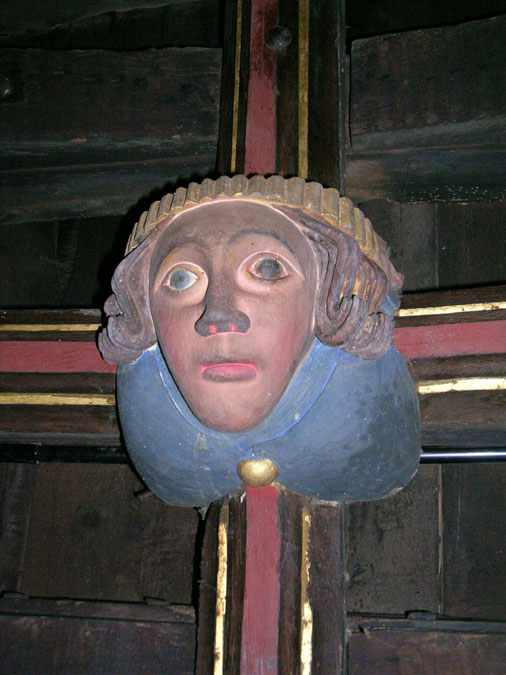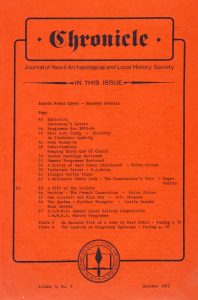This article came from the Chronicle published October 1985. Pages:43-44
Summer Programme Reviewed
Authors: Various
APRIL 26TH HINTON ST GEORGE WALKABOUT. The first excursion of the summer programme took the form of a “walkabout” at Hinton St. George conducted by one of our members, Mr. Ron Gilson. Hinton is reckoned to be one of the “perfect” villages, possessing a fine 15th century church, a goodly number of mediaeval houses built mainly of the local Ham Hill stone and an ancient village cross with John the Baptist carved on its tall shaft. It owes its importance to the Poulett family who came there in the 15th century and held the manor until quite recently. The church of St. George has a fine high tower with pinnacles and pierced battlements. The porch has a ribbed stone roof and ancient timbers remain in the panelled roofs of the nave and south aisle. The church contains many tombs of the Poulett family, some elegant, some less re-strained and others rather extravagant which dominate the building. Special arrangements had been made for the party to view the Poulett pew and chapel which have a separate (locked) entrance on. the north side of the church. Leaving St. George’s we made our way around the village, being given expert opinion on the ground-plans and elevations of most of the important houses, including the so called Priory and the Great Manor House. This was built by Sir Amyas Poulett again in the 15th century. It has been altered and added to through the centuries, but still retains much of its original grandeur. We were very fortunate in having such an authority as our guide. Ron Gilson’s knowledge of venacular architecture helped us to appreciate how much Hinton St. George has to offer in interest and pleasure.
MAY 18TH HARDY’S COTTAGE AND TOLPUDDLE. On a lovely Saturday afternoon in May, a small group of members met at the County Library Dorchester, where we were able to peruse copies of contemporary records relating to the Tolpuddle Martyrs, before visiting the small but very interesting museum at Tolpuddle later in the day. On leaving the library, we made our way to Hardy’s Cottage at the hamlet of Higher Bockhampton. After walking through woodland carpeted with bluebells, we arrived at the small thatched house which was the birthplace of Thomas Hardy in 1840. The cottage was built by his great grandfather and has been little altered. On arrival at the Tolpuddle Martyr’s Museum, we were able to view exhibits connected with the events which led to six farm labourers being sentenced in 1834 to seven years transportation to Australia for trades union activities.
JUNE 7TH ILMINSTER WALKABOUT. Only 10 members gathered outside Market Ilminster House in Ilminster on a bright June evening to be greeted by our guide Mr. George Maher who began by pointing out the George Hotel, one of Ilminster’s oldest buildings dating from 1650. Queen Victoria stayed there when only 6 months old. The market place had seen less happy times because 11 people were hanged there after the Monmouth rebellion, including Sir George Speke. Our guide led the party to the Unitarian Chapel. Founded in 1719, it has now only a dwindling congregation. Inside, we saw the fine organ but it was apparent that without considerable assistance the chapel was doomed to decay. Joining the A30 at the top of the town we passed an old water pump and were shown the grand gateway which was once the main entrance to Dillington House. Less pretentious was Bay House, the home of Sue Brown, famous as the Oxford University Boat Race Cox. Near the Parish Church is the former Grammar School which was founded in 1549 and closed in 1971. It bears a recently restored sundial inscribed with the date 1586. Of particular note was the Head Master’s House in Court Barton and the Dolphin Hotel, dating from 1676. St. Mary’s Church is perpendicular on a grand scale, with an imposing central tower of c 1450. The tombs in the north transept are of special interest. The earliest is an altar tomb capped by a fine slab of Purbeck Marble bearing the monumental brasses of Sir William Wadham and his mother Lady Joan Wadham (engraved c 1440). The Elizabethan monument to Nicholas and Dorothy Wadham also has brasses with a reversed inscription. In complete contrast we visited tPe Junior School with, its indoor swimming pool and class rooms gaily decorated with childrens’ work. The return journey to the market place took us past the offices of the “Somerset University” which was the only blot on a very interesting tour. We warmly thanked Mr. Maher for the trouble he had taken to show off a town of which he is justly proud.
JUNE 22ND GLOUCESTER CATHEDRAL AND CITY. The first all day excursion. of the summer programme took the form of a visit to the City of Gloucester. Planned visits were made to the Robert Opie Museum of Domestic Packaging and tile Cathedral. The first port of call was the Robert Opie Museum housed in a disused dockside warehouse. Its founder is a dedicated collector of all sorts of packets and containers of proprietary foods, medicines, cures for every ailment and a hundred and one domestic necessities. It spans a period of about 50 years. After this visit members were free to explore other parts of the historic city until the afternoon when a tour of the Cathedral was arranged. Some members visited the Gloucester Folk Museum: housed in three mediaeval timber-framed buildings which were built between the 15th and 18th centuries. This contained a fascinating collection depicting the social history, folk lore, crafts and industries of the City of Gloucester. The Museum interior revealed magnificently, the massive timber construction of the houses and added atmosphere was created by the creaking of the uneven original flooring – an altogether remarkable experience. Mr. Robert Martin conducted the party round the Cathedral covering many parts of the building which were expertly described. He dealt with the history of the Church from a simple monastic settlement up to the present time and described the architecture, stained glass and monuments – indeed,a comprehensive survey of a magnificent Church. Some members were able to include visits to an excellent Costume Museum, the “Beatrix Potter” exhibition and the redundant church of St. Nicholas where conservation work was in progress on one of the monuments. Altogether it was a very busy day out which, despite inclement weather, everyone seems to have enjoyed.
JULY 12TH HORNSBURY MILL. This was the scene of a visit by a small party of members and friends on a Friday evening in early July. It is situated about a mile out of Chard on the Taunton road. It is a good example of an early 19th century corn mill but it is certain that there was a mill on the same site before then. The earliest specific reference being 1327 in the Diocesan Register of Wells Cathedral. Commercial milling stopped in 1942. In 1968 the present owners took over the mill and, after five year’s work on conversion and extension, it was opened to the public in 1973. The old stables have been converted into a restaurant, with a fine view of the great water wheel which is fed by the River Isle. The mill itself remains intact including the hopper floor, drying floor, milling floor and the bagging room, with all the machinery in situ – grinding stones, shafting, milling gear etc. The three upper rooms are set out as a museum of bric-a-brac and display a fascinating collection of tools and apparatus associated with milling and many local rural crafts. Members first partook of a supper in the restaurant before undertaking a tour of the bric-a-brac museum and a visit to the inevitable souvenir shop. The weather was kind, the scenery was rural, serene and tranquil and indeed it was a most enjoyable evening.
JULY 26TH MARSTON MAGNA. The parish church together with the moated manor house site and the adjacent field system behind the church, was the venue for an evening visit by about 25 members. It was conducted by Enid Pawley and Bill Chapman. Following a welcome from the Rector, the party moved out to the site of the mediaeval manor house, complete with a well-constructed moat, a mill and a large fish pond. These features were clearly defined and explained by Bill. Adjoining this site is a field system with a large area of very clearly defined ridge and furrow, undamaged by modern ploughing. The manor site is now listed but it seems the field system is not. Of the church itself, there are a number of features which indicate the different periods of building. There are 13th century windows above a much older wall at the eastern end of the chancel and areas of “herring bone” pattern masonry are easily discernable on the north wall. The nave followed the chancel and it has a modern tiled roof. The chancel arch dates from the 14th century. A small amount of mediaeval glass can be seen in a south window of the chancel. There is a robust Norman font with delicate carving around the basin. The Jacobean pulpit has a Georgian “Tester”. Traces remain of the Rood stairs and in the 15th century chapel can be seen a somewhat faded wall painting, depicting the martyrdom of Thomas-a-Becket. It is a most interesting parish church, right on our doorstep. John Moon thanked Enid and Bill for a very worth-while visit.
AUGUST 31ST HALSTOCK ROMAN VILLA. Bad weather in the morning and memories of the downpour at last year’s visit probably contributed to a very reduced turnout for the Halstock visit. However, the weather greatly improved and those who did tackle the mud of Long Lane were more than rewarded. Shortly after arriving at the site, members witnessed an exciting discovery. One of the excavation team had just found an almost intact water pitcher 14 feet down a Roman well from which the infilling black mud was being removed. It came up complete with handle, only lacking part of its rim. Even the usually imperturbable site director, Ron Lucas, was excited by this important discovery. This year’s excavations were located in. the N.W. corner of the villa courtyard and they had revealed a stone lined water drainage system and many post holes. The well was the most significant feature but. it had only come to light in the final week of the dig. Ron Lucas confirmed that this was his last season at Halstock because it was time to concentrate on writing up tile report. He showed members other finds from this year’s work including pottery, bones and bronze bracelets. Bill Chapman thanked him on behalf of the Society and added that members were looking forward to his lecture next spring.

